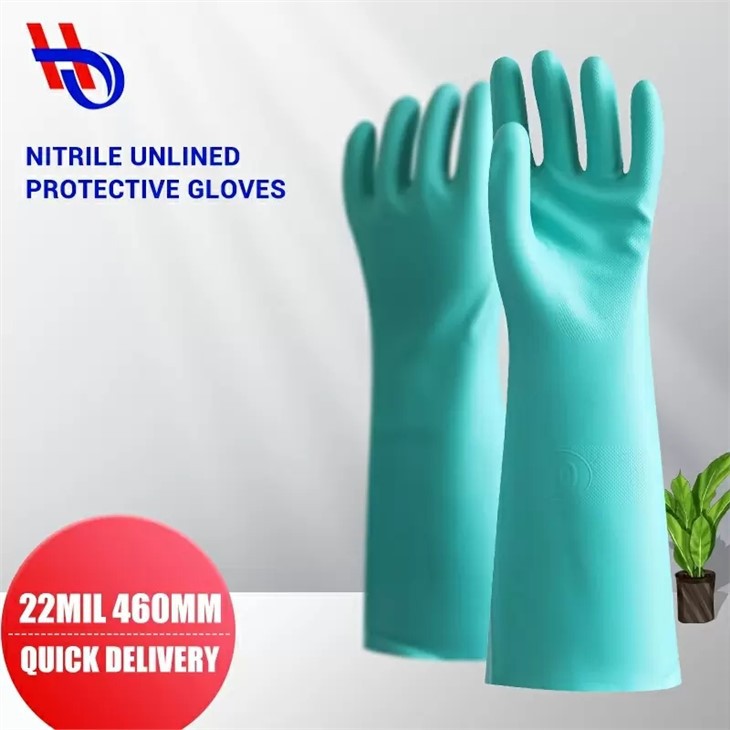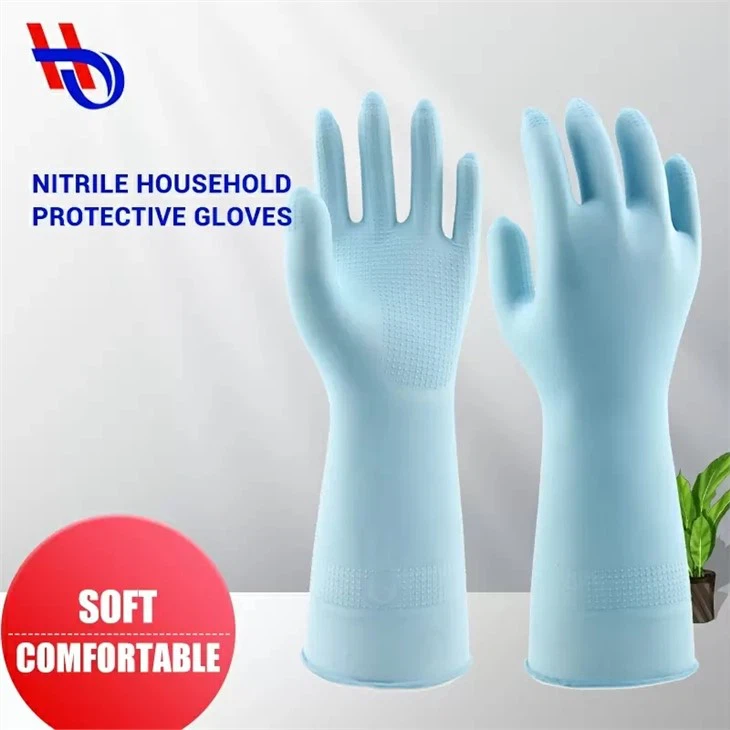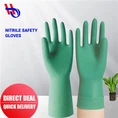Nitrile Examination Gloves
What is Nitrile Examination Gloves
Latex GaloshesDisposable examination gloves, or ‘medical grade gloves' are typically used by those working in the medical, healthcare and hygiene fields, as well as by some laboratory workers. Unlike surgical gloves, exam gloves are used for examining patients and materials only, and not intended for use alongside surgical equipment. Their primary role is to prevent cross-contamination between patients and healthcare workers, and potentially harmful or contaminated materials. For this reason, they must be disposed of after coming into contact with each patient or each hazardous or infectious material.
Nitrile exam gloves are made from synthetic rubber, unlike natural rubber latex gloves. The nitrile material benefits from resistance to oil and a range of chemicals, is tear-resistant, and has a high level of puncture resistance. Given their superiority to latex gloves and particularly vinyl gloves in terms of durability, these disposable gloves are becoming an increasingly popular choice for the medical and healthcare fields.
Advantages of Nitrile Examination Gloves
Highly durable
The nitrile gloves are proved to be highly durable as nitrile is not as flexible as natural rubber and as a result they don't provide much dexterity as provided by latex gloves. It is usually 3 to 5 times more puncture resistance as compared to latex, enabling them for a much longer use.
Protection from blood borne pathogens
The nitrile gloves provide safety from the blood borne pathogens, making them the most adequate fit for the medical and healthcare environments and they are popularly referred to as exam gloves or surgical gloves. Hppe cut resistant gloves are extremely durable and provide high longevity.
Extremely comfortable
The nitrile gloves are considered to be extremely comfortable due to its 100% latex free construction. As the construction quality of the gloves is highly comfortable, one can easily wear them for extended periods of time without any feeling of discomfort or uneasiness making them highly suitable for long wear.
Why Choose US
Our factory
Beijing Huateng Rubber and Plastic Latex Products Co., Ltd. was established in 1958. The company has excellent performance in China's latex impregnation products. The registered capital of the Company is 120 million yuan, and the value of fixed assets is 258 million yuan. The annual turnover exceeds 800 million yuan.
Our Product
We mainly develop nitrile protective gloves and neoprene protective gloves. At the same time, our company provides different kinds of work gloves, protective gloves and waterproof boots to the domestic and foreign markets.
Our certificate
The company has passed ISO9001: 2015 quality management system and ISO14001 environmental management system certification. Latex gloves have passed EU CE certification
Production equipment
It has strong scientific research and development ability and technical testing means, and the factory has complete industrial sanitation, labor protection and fire protection facilities that meet the environmental protection standards.
Powerful industrial production utilities
Power supply capacity is 4250KVA, and water supply capacity is 240t/h circulating water capacity. 300t/h, heating capacity 32t/h, the water supply and drainage facilities in the plant area are complete and connected with the municipal pipe network.
Uses for Nitrile Gloves




When it comes to nitrile gloves, they can be used in an almost unlimited number of ways and across dozens, if not hundreds, of professions. In fact, thanks to the nature of these gloves, nitrile has often become the first choice for many professionals throughout the globe. Nitrile gloves are often used in the following ways, though this is certainly not a complete list:
The medical industry loves this material, as it provides great protection against contamination and better durability than latex.
Scientists handling caustic or dangerous materials rely on these gloves to ensure they have enough dexterity to handle samples safely.
Tattoo artists and body piercers use these gloves to keep their customers safe and healthy while performing body modifications.
Food service professionals use nitrile gloves as the material can be made food-safe, making these gloves an excellent choice for preparing, handling, and serving food.
Hairdressers often wear these gloves while dyeing or treating customers' hair to protect themselves from hair chemicals and to provide a sterile environment for their customers.
Auto mechanics and other tradesmen use nitrile gloves to protect themselves from grease, oil, and other related damage while working on engines, transmissions, and other components.
While Carpenters and construction workers don't use disposable nitrile gloves very often, many wear cloth or canvas safety gloves coated in nitrile to provide an extra layer of protection and grip while on the job.

Nitrile gloves are made from synthetic rubber that does not contain latex and is, therefore, safe for contact with people suffering from a latex allergy. These types of gloves have traditionally been less flexible than latex gloves and offered less sensitivity for the fingers and hands. However, due to advances in the manufacturing of nitrile exam gloves, they have become much thinner, more flexible, and suitable for use in healthcare and related fields. Nitrile exam gloves also come in static-free and powder-free varieties (glove powder can potentially contaminate working surfaces and testing, or interfere with wound healing), making them suitable for a variety of uses.
The important advantage of nitrile exam gloves over latex gloves lies not only in the absence of latex but in their robustness. Although nitrile gloves have become thinner and more flexible in recent years, they still offer a high level of resistance to many chemicals, as well as protection against punctures and tearing. This is particularly important for those working in the healthcare and medical sectors, where durability is equally, if not more important, than sensitivity.
Why glove sizing needs to be done properly
While it may seem like common sense when it comes to ensuring you're wearing gloves of the proper size, it does bear pointing out exactly what the dangers are when it comes to incorrect glove sizing. First and foremost, trying to wear gloves that are either too small for your hands or too large for them can result in making it difficult to complete necessary tasks while wearing them. More importantly, though, you could end up injuring your hands as well.
Gloves that are too small are simply uncomfortable to wear, as they can compromise dexterity and cause hand fatigue. Rips or tears to the glove itself become more common if the material of the glove is being stretched beyond its capabilities, exposing you to hazards. Meanwhile, gloves that are too big for your hands can be caught on tools, machinery, or any other hazards, resulting in either the glove being pulled off completely or causing your hand to become lodged in an unsafe and dangerous place.
Glove size measure techniques
It's obvious that you need to ensure you're wearing the right glove size. But how do you get a properly fitting glove? The key here is that you need to understand how to measure your hand properly so that you can then translate that measurement into the right glove size.
There's more than one method for determining the right size. One of these methods is conducted by measuring how wide your dominant hand is. This involves the use of a soft cloth tape measure. You should always use your dominant hand, as it tends to be slightly larger than your other hand; make sure you measure your right hand if you're right-handed (and left vice versa). Simply place the measuring tape in the palm of your hand right where your first and second fingers meet and wrap it horizontally around, making sure to leave your thumb out of the measurement. Record your hand width in both inches and millimeters if possible, as some sizes may be listed in one measurement instead of the other.
Figuring out non-standard glove sizes
Many gloves come in sizes measured in either millimeters or inches, but some come in non-standard sizes. In the united states it's common to see gloves offered in relative sizes, ranging from small (or extra small) to xl or even xxl. Meanwhile, many european-based manufacturers will use numbered sizes, often starting at 6 at their smallest size and going as high as 11. This can make sizing safety gloves challenging. However, in most cases you can equate the measurements you took along the following lines:
For us sizes, xs typically begins at 6-7 inches or 152-178 millimeters. Each subsequent glove size goes up by around an inch or 25 millimeters or so, with small glove fitting for people with hand sizes of 7-8 inches or 178-203 millimeters, medium for 8-9 inches or 203-229 millimeters, and so on. Meanwhile, european sizes 6 through 11 are roughly equivalent to xs through xxl.
Identifying the right size glove by hand length
In addition to hand width, there are other ways to measure the right size glove for you. Many gloves are offered in not just different hand width sizes but also offered in different hand lengths as well, and this means it's just as important to determine your own hand length as well so you can more easily choose a glove size by these measurements as well.
There are two different aspects when it comes to glove length. First, the one where you can measure involves taking your cloth measuring tape and measure from the tip of your middle finger (which is almost always your longest figure) to the base of your hand where it meets your wrist. This will give you the measurement needed to determine your glove size if measured by hand length.
However, there is a second aspect of glove length as well that doesn't involve hand length. While types of safety gloves typically stop at the wrist, others may be much longer depending on how much protection is needed. It's typical for a glove size to also include how far up the forearm the glove fits. Gloves used for cleaning with caustic chemicals can be as long as 18 or even 24 inches to protect the forearms, while gloves meant for heavy industry might be even longer. Meanwhile, the typical disposable glove size for a doctor or nurse during a routine examination will usually measure no more than 9 to 12 inches long.
Steps for Removing Gloves Safely
Protecting your clients and patients by wearing gloves carefully is not enough. You also need to protect yourself from getting contaminated. To help you out, here are the steps on how to remove gloves properly:
Grasp the outside
While still wearing gloves, grasp the outside of one gloved hand on the top of your wrist. The non-dominant hand is usually used for this step. Be careful not to pinch yourself or get in contact with your bare skin, scrubs, or arm.
Peel off
Peel the disposable gloves away from your body, wrist, and fingers. The disposable gloves will be inside out, and that's what you want. It should be in a ball shape. The interior, which is disinfected, will be exposed. This is for safety and sanitation purposes.
Hold
Hold the removed disposable glove in your palm with your other gloved hand.
Insert and peel off
Insert your ungloved hand inside the second glove at the top of your wrist. Be careful not to get in contact with the exterior of the disposable glove.
Inside out
Peel the second glove away from yourself while still holding the first glove. Turn the second glove inside out. The first glove will be strapped inside the second glove. This makes disposable safer and easier.
Disposal
Dispose of used gloves properly. Throw disposable gloves in the right garbage bin to make sure they are handled the right way, and no one will reuse them.
Always throw your used gloves in the biohazard bin or container. If there are no biohazard bags near you, place contaminated disposable gloves in a sealed, leak-proof container or sturdy plastic bag. Make sure to seal them properly to decrease potential risks of spreading or contamination.
Suppose you are working in a medical, food, or health-related establishment. In that case, there are specific policies that you need to follow for the proper disposal of contaminated gloves, scrubs, and other materials. Always check your company policy.
Wash your hands
Don't touch any surface or objects. This can spread bacteria, germs, and viruses. Wash your hands using clean soap and water immediately after taking your gloves off.
The Impact of Examination Gloves on Infection Control
Infection control remains a cornerstone of healthcare, critically important in safeguarding patient and practitioner health. Examining gloves stands out as a fundamental tool within this broad and vital field. Originally introduced as a barrier to protect patients from the risk of infection, these gloves have evolved to serve as a critical component in the healthcare professional’s armour against a myriad of infectious agents.
The journey of examination gloves in the medical field is a fascinating blend of innovation and necessity. The initial use of medical gloves dates back to the late 19th century, primarily introduced to protect patients from the risk of infection during surgeries. Initially, these gloves were made of rubber, a material that provided a basic level of protection and was reusable after sterilization. However, as the understanding of infection control deepened, the materials and designs of these gloves evolved significantly.
Today, examination gloves are made from various materials, each catering to different sensitivities and specific medical needs. Latex gloves, once the standard, are now often replaced by nitrile or vinyl options due to latex allergy concerns. The design of gloves has also seen advancements, with features like textured surfaces for better grip and powder-free options to reduce contamination risks. This evolution underscores the medical community's commitment to improving safety standards and adapting to emerging challenges in infection control.
Washing nitrile gloves, requires extra care. You don't want to wash off the chemical essence or tear them, yet you need to clean them thoroughly.
Step 1: Keep wearing reusable nitrile gloves after use.
Step 2: Put your clad palms under running hot water.
Step 3: Apply liquid soap and wash any substances off the gloves.
Step 4: Rinse off the gloves, remove them and wash your hands.
Step 5: Soak the gloves in warm water and soap for 3-5 minutes while flipping them inside out.
Step 6: Rinse the gloves and hang them to dry.
Step 7: After drying, wipe the gloves with disinfectant and store them in a cool, dry place.

FAQ
We're well-known as one of the leading nitrile examination gloves manufacturers and suppliers in China. Please feel free to wholesale high quality nitrile examination gloves at competitive price from our factory. For OEM service, contact us now.
Nitrile Protective Gloves, Industrial Nitrile Gloves, Disposable inspection gloves










